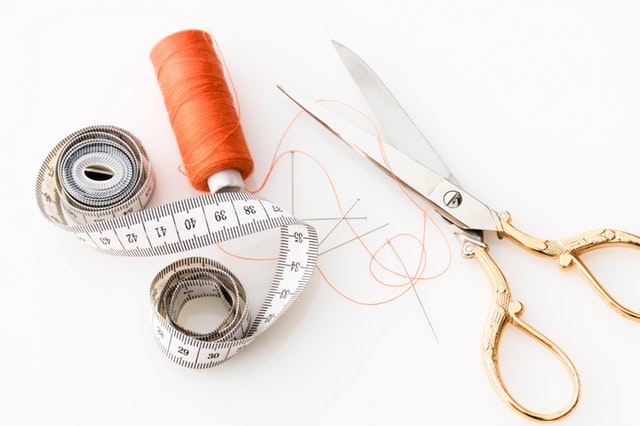It is important to know the amount of thread consumed in a sewn product so you can: 1) estimate the number of cones needed; and 2) calculate the cost of the thread needed to manufacture the finished product. Thread consumption can be determined in several ways. To calculate the amount of thread in a seam, you can:
- Measure the actual amount of thread consumed in a specific length of seam.
- Calculate the thread consumption by using mathematical stitch formulas based on the thickness of the seam and the number of stitches per inch.
Measuring Actual Thread Consumed
A specified length of the seam, for example 3 inches, is measured and then the thread is removed by carefully unraveling the stitch. You can then calculate the amount of thread consumed in one inch and multiply this factor times the total length of the seam measured in inches.
Example:
- Length of seam is 42 inches or 1.17 yards.
- Stitch and seam construction: 401 SSa-1.
- Specified length of thread removed from a seam equals 3 inches.
- Needle thread removed = 9 inches
- Looper thread removed = 8 inches
Calculation:
- Needle thread factor = 9 ¸ 3 = 3 inches of needle thread per inch of seam.
- Looper thread factor = 8 ¸ 3 = 2.67 inches of looper thread per inch of seam.
- Total needle thread consumed = factor 3 X 1.17yds = 3.51 yds
- Total looper thread consumed = factor 2.67 X 1.17yds = 3.12 yds
- Total Thread = 3.51 + 3.12 = 6.63 yards per seam.
- Generally a 10 to 15% waste factor is added due to chaining-off, thread breaks, repairs, etc.
- If a waste factor of 15% is selected then:
– 6.63 yards/seam X 1.15 = 7.62 yards/seam including 15% waste factor.
Obviously you must do this for
each seam to determine the total amount of thread consumed in the finished
product.
Thread Consumption Formulas
Union Special Machine Company published a “Thread Consumption Booklet” that consists of a number of thread consumption formulas for various stitch types based on the stitch length and thickness of the seam. These mathematically derived consumption factors can be multiplied times the length of the seam to estimate the combined amount of top and bottom thread. On some overedge and coverstitch types it is necessary to also know the seam width or needle spacing to properly calculate the amount of thread consumed.
Example:
Stitch and seam: 401 SSa-1 Stitches per inch: 8
Thickness of the seam: .075 inches (measured with a micrometer) Length of the seam: 42 inches or 1.17 yds.
Union Special 401 Chainstitch Chart
| SEAM THICKNESS | 8 SPI |
| .055 | 4.88 |
| .060 | 4.96 |
| .065 | 5.04 |
| .070 | 5.12 |
| .075 | 5.20 |
Consumption based on the mathematical equation – C = 4 + 2ts
C = 4 + 2(.075 X 8) = 5.20
t = thickness of the seam s = stitches per inch
1.17 yds X 5.20 = 6.08 yds / seam.
6.08 yds/seam X 1.15 = 7.00 yds per seam including a 15% waste factor.
ESTIMATING THREAD CONSUMPTION USING ANECALC
A&E’s ANECALC thread consumption and costing tool was developed using the Union Special thread consumption formulas. To use this tool effectively, you should do the following:
- Select the correct ANECALC spreadsheet before you begin your analysis. For apparel, you can choose from the following spreadsheets:
- Light Weight Fabrics:- yards or meters
- Medium Weight Fabrics:- yards or metres
- Heavy Weight Fabrics:- yards or meters
- Make a sequence of sewing operations and for each operation, determine the stitch type, the number of rows of stitch, the SPI, and the length of the seam.
- Last, decide on what thread size and type you are currently using or you are thinking about using.
Obviously, the factors that can affect thread consumption include the thickness of the fabric, the stitch type being used, the number of rows of stitch in a seam, the SPI and the length of the seam.
ANECALC spreadsheets have Tabs with Help Guides and well as ISO4915 Stitch Identification Charts.
Notice that the bottom part of the spreadsheet allows you to calculate the thread cost per garment as well as the number of cones required for a particular Program Size.
Another benefit of this tool, is that you can have multiple thread types used on the same spreadsheet.
ANECALC will easily allow you to see what the total thread consumption is by SKU.
Blank ANECALC spreadsheets are available on
A&E’s website at www.amefird.com. We
also have basic spreadsheets, as well as spreadsheets for Knits that include a
Cover-thread column if the cover-thread is different from the looper thread
being sewn.
How accurate is ANECALC in estimating the thread consumption for a sewn product? It has been our Technical Support Team’s experience that ANECALC is accurate to 2 to 3% of the actual thread consumed using method #1 described above and is much faster to do.
| Source:- www.amefird.com. |




